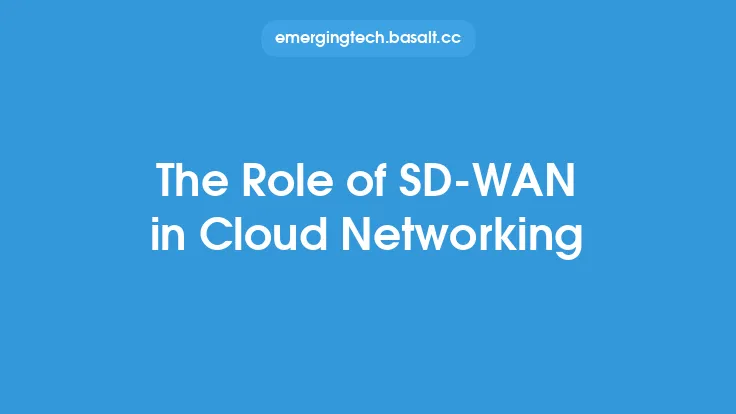Cloud networking protocols are the backbone of cloud computing, enabling communication and data exchange between various cloud-based systems, applications, and services. These protocols play a crucial role in ensuring the efficient, reliable, and secure transmission of data across the cloud infrastructure. In this article, we will delve into the world of cloud networking protocols, exploring their types, functions, and importance in the cloud computing ecosystem.
Introduction to Cloud Networking Protocols
Cloud networking protocols are standardized sets of rules and procedures that govern the communication between devices, systems, and applications in a cloud environment. These protocols are designed to facilitate the exchange of data, ensure network reliability, and provide security features to protect against unauthorized access and data breaches. Cloud networking protocols can be categorized into several types, including network protocols, transport protocols, session protocols, and application protocols. Each type of protocol serves a specific purpose and is used in different layers of the cloud networking architecture.
Types of Cloud Networking Protocols
There are several types of cloud networking protocols, each with its own unique characteristics and functions. Some of the most common cloud networking protocols include:
- HTTP (Hypertext Transfer Protocol) and HTTPS (Hypertext Transfer Protocol Secure): used for communication between web servers and clients
- TCP (Transmission Control Protocol) and UDP (User Datagram Protocol): used for reliable data transfer and real-time applications
- DNS (Domain Name System): used for domain name resolution and IP address mapping
- DHCP (Dynamic Host Configuration Protocol): used for dynamic IP address allocation and network configuration
- SSL/TLS (Secure Sockets Layer/Transport Layer Security): used for secure data encryption and authentication
- BGP (Border Gateway Protocol): used for routing and network topology discovery
- OSPF (Open Shortest Path First): used for routing and network topology discovery
Functions of Cloud Networking Protocols
Cloud networking protocols perform several critical functions in the cloud computing ecosystem. These functions include:
- Data transmission and reception: cloud networking protocols enable the transmission and reception of data between devices, systems, and applications in the cloud
- Network routing and topology discovery: cloud networking protocols help discover the network topology and route data packets between devices and systems
- Error detection and correction: cloud networking protocols detect and correct errors that occur during data transmission
- Flow control and congestion avoidance: cloud networking protocols regulate the amount of data that can be transmitted at one time, preventing network congestion and ensuring reliable data transfer
- Security and authentication: cloud networking protocols provide security features such as encryption, authentication, and access control to protect against unauthorized access and data breaches
Importance of Cloud Networking Protocols
Cloud networking protocols are essential for the smooth operation of cloud-based systems, applications, and services. They provide a standardized framework for communication, ensuring that data is transmitted efficiently, reliably, and securely. The importance of cloud networking protocols can be seen in several areas, including:
- Scalability and flexibility: cloud networking protocols enable cloud providers to scale their infrastructure and services to meet changing demand
- Reliability and uptime: cloud networking protocols ensure that cloud-based systems and applications are always available and accessible
- Security and compliance: cloud networking protocols provide the necessary security features to protect against unauthorized access and data breaches, ensuring compliance with regulatory requirements
- Interoperability and compatibility: cloud networking protocols enable seamless communication between different cloud-based systems, applications, and services, ensuring interoperability and compatibility
Challenges and Limitations of Cloud Networking Protocols
While cloud networking protocols are essential for the cloud computing ecosystem, they also present several challenges and limitations. These challenges and limitations include:
- Complexity and management: cloud networking protocols can be complex and difficult to manage, requiring specialized skills and expertise
- Security risks: cloud networking protocols can be vulnerable to security risks such as hacking, eavesdropping, and data breaches
- Performance and latency: cloud networking protocols can impact network performance and latency, affecting the overall user experience
- Interoperability and compatibility: cloud networking protocols can be incompatible with different cloud-based systems, applications, and services, affecting interoperability and compatibility
Best Practices for Implementing Cloud Networking Protocols
To ensure the efficient, reliable, and secure transmission of data in the cloud, it is essential to follow best practices for implementing cloud networking protocols. These best practices include:
- Conducting thorough risk assessments and security audits to identify potential vulnerabilities and threats
- Implementing robust security measures such as encryption, authentication, and access control
- Configuring and managing cloud networking protocols correctly to ensure optimal performance and reliability
- Monitoring and analyzing network traffic and performance to identify areas for improvement
- Ensuring interoperability and compatibility with different cloud-based systems, applications, and services
Conclusion
In conclusion, cloud networking protocols are a critical component of the cloud computing ecosystem, enabling communication and data exchange between various cloud-based systems, applications, and services. Understanding the types, functions, and importance of cloud networking protocols is essential for ensuring the efficient, reliable, and secure transmission of data in the cloud. By following best practices for implementing cloud networking protocols and addressing the challenges and limitations associated with them, cloud providers can ensure the smooth operation of their infrastructure and services, providing a high-quality user experience and maintaining the trust and confidence of their customers.





